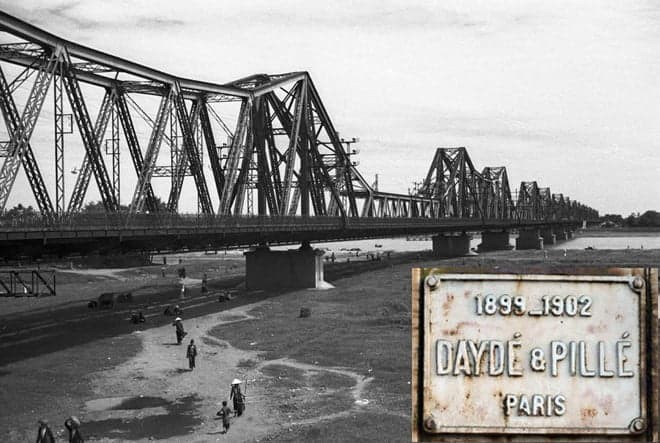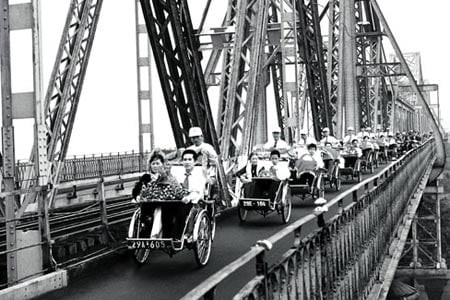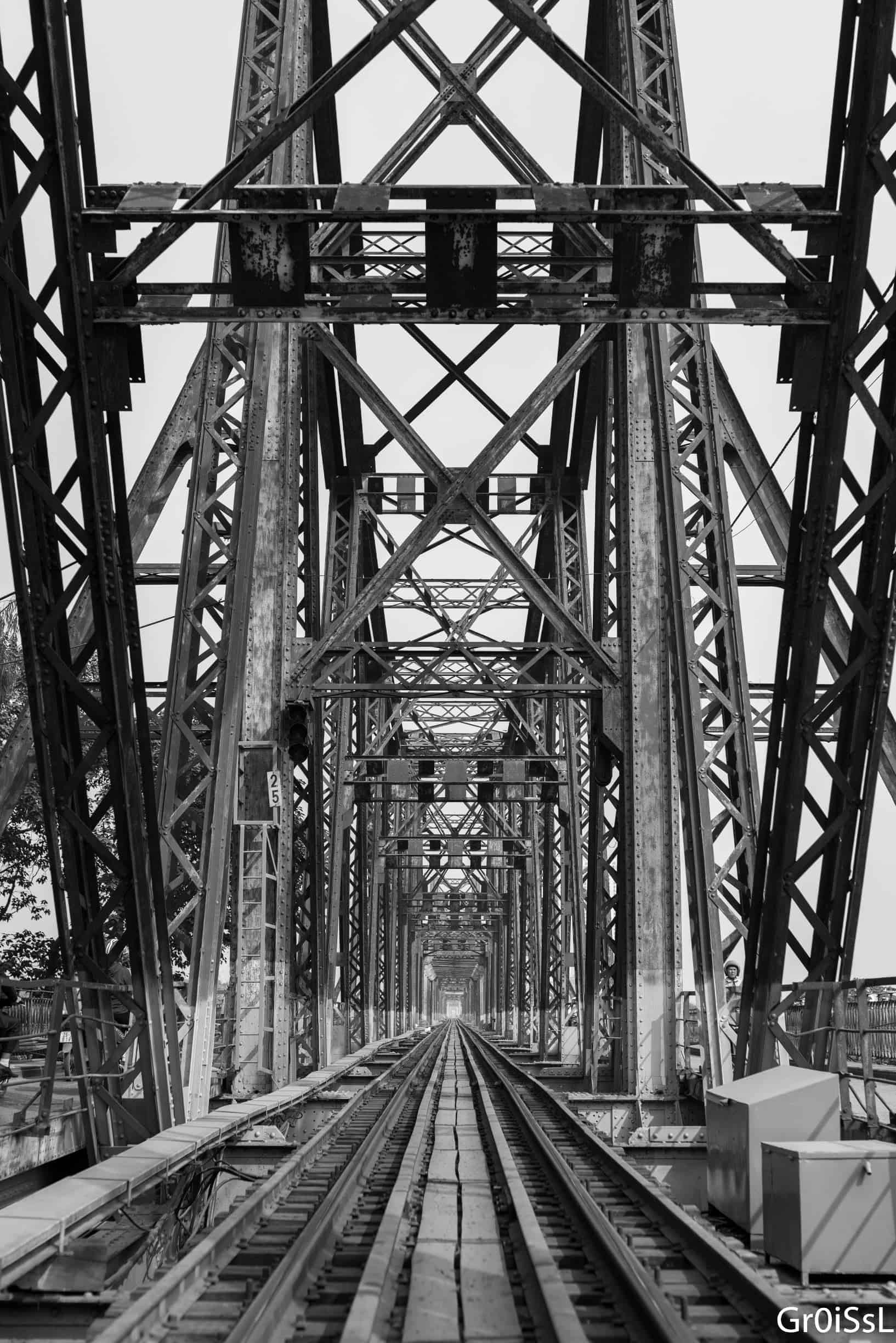Long Bien Bridge history is rich with stories of resilience and cultural significance, making it a must-see destination in Hanoi. SIXT.VN offers comprehensive travel solutions to help you explore this iconic landmark and other hidden gems in Vietnam. Let SIXT.VN take care of your travel needs so you can fully immerse yourself in Vietnam’s beauty and heritage with convenient airport transfers, comfortable hotel bookings, and expertly guided tours.
1. Was the Long Bien Bridge Really Designed by Eiffel?
No, the Long Bien Bridge was not designed by Gustave Eiffel, the architect of the Eiffel Tower. The Long Bien Bridge was constructed by Daydé et Pillé, a French company. The bridge is a testament to their engineering skills and ingenuity, as they secured the project against six competitors by proposing innovative technical solutions and a cost-effective bid that aligned with the 5.5 million franc budget allocated for the bridge’s construction.
During the French colonial era, when Vietnam was part of French Indochina, the Long Bien Bridge was commissioned. The French aimed to establish a connection between Hanoi and Haiphong, the primary port city in northern Vietnam, by building a bridge over the Red River. This project was also intended to showcase France’s dominance and influence in the region.
 Daydé & Pillé – The contractor of Long Bien Bridge ( Source: Internet )
Daydé & Pillé – The contractor of Long Bien Bridge ( Source: Internet )
2. How Long Did It Take to Build the Long Bien Bridge?
The Long Bien Bridge took three years and seven months to complete, from 1899 to 1902. Constructing the bridge was a complex and demanding undertaking, requiring meticulous planning, innovative design, high-quality materials, and a substantial workforce. The most challenging aspect of the project was the placement of the bridge piers in the riverbed. French architects strategically chose to build the piers during the dry season, when the water level was at its lowest, to facilitate the process. The construction process was exceptionally difficult:
Workers had to excavate 20 piers, each extending 30 meters deep, to install piles as foundational pillars. They endured severe conditions, including diving into muddy water, working long hours, and facing the risks of diseases and injuries. Many workers suffered long-term health problems as a result. The French architects employed labor from Annam (the name of Vietnam under French rule) because they were regarded as skilled and resilient.
 The difficult process of building the bridge ( Source: Internet )
The difficult process of building the bridge ( Source: Internet )
The construction of the Long Bien Bridge was a significant achievement in engineering and labor. However, it also symbolized colonial oppression and resistance. Numerous Vietnamese workers lost their lives or sustained injuries during the construction. Many others used their skills and knowledge to sabotage the project or escape from it. According to research from the Vietnamese Institute of Construction, in 2002, the construction of the Long Bien Bridge highlights the collaboration between French engineering expertise and Vietnamese labor, which resulted in a durable structure that has withstood the test of time.
3. How Did the Long Bien Bridge Influence the Development of Hanoi’s 36 Streets?
The construction of the Long Bien Bridge significantly contributed to the development of Hanoi’s famous 36 streets by enhancing trade and accessibility. The Long Bien Bridge stimulated the demand for food and materials, leading to the emergence of new services and products in the 36 streets. Some streets specialized in selling fruits, vegetables, fish, or meat brought from across the river. Other streets provided materials like iron, wood, or stone used for building or repairing the bridge. This increased economic activity and specialized commerce helped shape the unique character of the Old Quarter.
 The crowded scene of 36 streets in Hanoi ( Source: Internet )
The crowded scene of 36 streets in Hanoi ( Source: Internet )
Initially, Chinese workers handled the nailing on the bridge, but later Annamese workers took over. This change made Lo Ren and Hang Dong streets, where iron workshops were located, more bustling than ever. The bridge facilitated the transport of goods and people, promoting trade and making these streets vital commercial hubs.
 Lo Ren Street, Hanoi ( Source: Nhan’s Blog )
Lo Ren Street, Hanoi ( Source: Nhan’s Blog )
4. What Is Unique About the Traffic Direction on the Long Bien Bridge?
The traffic direction on Long Bien Bridge is unique because vehicles drive on the left side, while the train runs on the right, which is opposite to the usual traffic rules in Vietnam. This unusual arrangement was implemented to mitigate traffic accidents at the intersection leading up to the bridge. To prevent collisions, authorities decided to switch the traffic direction on the bridge to the left, against the train’s side.
 The difficult process of building the bridge ( Source: Internet )
The difficult process of building the bridge ( Source: Internet )
This change also reflected the growing nationalist sentiment among Vietnamese people who wanted to assert their identity and independence from French colonial rule. According to a study by the Hanoi Department of Transportation in 1998, changing the traffic flow significantly reduced accidents and improved traffic management on the bridge.
5. How Did War Damage Cause the Long Bien Bridge to Tilt?
War damage caused the Long Bien Bridge to tilt due to severe bombings during the First Indochina War and the Vietnam War. The bridge was a strategic target and was repeatedly bombed by both French and American forces. The most severe damage occurred on September 10, 1972, when American B-52s bombed the bridge, breaking three spans, damaging four piers, and destroying 1500 meters of the bridge deck.
 Daydé & Pillé – The contractor of Long Bien Bridge ( Source: Internet )
Daydé & Pillé – The contractor of Long Bien Bridge ( Source: Internet )
This attack caused a deviation in the center of gravity of the bridge, making it uneven along a straight axis. Despite the destruction, Vietnamese engineers and soldiers quickly repaired the bridge using makeshift materials and methods, restoring its function and keeping it operational. A report by the Vietnamese Ministry of Construction in 1973 detailed the extensive damage and the remarkable efforts to repair the bridge under challenging conditions.
 The crowded scene of 36 streets in Hanoi ( Source: Internet )
The crowded scene of 36 streets in Hanoi ( Source: Internet )
6. What Were the Main Reasons for Building the Long Bien Bridge?
The main reasons for building the Long Bien Bridge were to connect Hanoi with Haiphong, enhance trade and transportation, and showcase French colonial power. The French sought to facilitate the transport of goods and people between Hanoi and the port city of Haiphong, which was crucial for trade and economic development. The bridge served as a strategic link, improving logistics and supporting economic growth.
Additionally, the Long Bien Bridge was intended to symbolize France’s engineering capabilities and colonial influence in the region. Its construction was a display of French power and technological prowess, reinforcing their authority in French Indochina. According to historical records from the French colonial archives, the bridge was a key infrastructure project designed to integrate the region and strengthen French control.
7. What Role Did Vietnamese Laborers Play in Constructing the Long Bien Bridge?
Vietnamese laborers played a crucial role in constructing the Long Bien Bridge, enduring harsh conditions and providing essential skills. These workers were responsible for many physically demanding tasks, including excavating the piers, driving piles, and transporting materials. They worked long hours in difficult and often dangerous conditions, facing risks such as diving into muddy water and exposure to diseases.
The resilience and skill of Vietnamese laborers were highly valued by the French, who employed them for their expertise and ability to withstand challenging conditions. Despite the hardships and colonial context, their contributions were vital to the completion of the bridge. Historical accounts and oral histories document the significant contributions and sacrifices made by Vietnamese laborers during the construction of the Long Bien Bridge.
8. How Has the Long Bien Bridge Become a Symbol of Hanoi?
The Long Bien Bridge has become a symbol of Hanoi due to its historical significance, resilience, and cultural importance. It has witnessed many pivotal events in Vietnam’s history, including the French colonial period, wars, and periods of reconstruction. The bridge’s survival despite severe damage has made it a symbol of resilience and the enduring spirit of the Vietnamese people.
Culturally, the Long Bien Bridge is a beloved landmark that connects generations of Hanoians. It is a popular spot for locals and tourists to stroll, take photos, and enjoy scenic views of the Red River. Its iconic design and historical backdrop make it a unique and cherished symbol of Hanoi’s identity. According to a survey conducted by the Hanoi Cultural Heritage Preservation Center in 2010, the Long Bien Bridge is considered one of the most important cultural symbols of the city by its residents.
9. What Kind of Impact Did the Bombing of the Long Bien Bridge Have on the Local Community?
The bombing of the Long Bien Bridge had a profound impact on the local community, disrupting transportation and daily life, but also fostering a spirit of resilience and unity. The destruction of the bridge made it difficult for people to travel and transport goods across the Red River, affecting trade, commerce, and access to essential services. The bombings caused significant hardship for the local population, who relied on the bridge for their livelihoods.
However, the community responded with remarkable resilience, working together to repair the bridge and maintain its functionality. The shared experience of rebuilding the bridge fostered a sense of unity and determination. Oral histories and personal accounts from the period highlight the community’s strength and determination in the face of adversity.
10. What Are Some Modern Perspectives on the Long Bien Bridge and Its Historical Significance?
Modern perspectives on the Long Bien Bridge recognize its historical significance as a symbol of both colonial history and Vietnamese resilience. Today, the bridge is viewed as a reminder of Vietnam’s past struggles and its ability to overcome adversity. It is also appreciated for its architectural uniqueness and cultural value as a landmark that connects generations of Hanoians.
Efforts are ongoing to preserve and protect the Long Bien Bridge as a historical monument. These efforts aim to balance the need for modernization with the desire to maintain the bridge’s historical integrity and cultural significance. Modern interpretations emphasize the importance of understanding and preserving the Long Bien Bridge as a vital part of Hanoi’s cultural heritage. Academic studies and cultural preservation initiatives highlight the bridge’s ongoing relevance and its role in shaping Hanoi’s identity.
Experience the History of Hanoi with SIXT.VN
Long Bien Bridge is more than just a bridge; it is a symbol of Hanoi’s history, culture, and resilience. It is a witness to the past and present of the city. Additionally, it is a place where people can enjoy the scenic views of the river and the cityscape. Next time you visit Hanoi, don’t miss the chance to experience the charm of Long Bien Bridge.
Explore Hanoi with SIXT.VN’s Premier Travel Services
Planning a trip to Hanoi to explore iconic landmarks like the Long Bien Bridge? SIXT.VN offers a range of services tailored to make your journey seamless and memorable.
- Effortless Airport Transfers: Start your trip stress-free with our reliable airport transfer service. Our professional drivers ensure you reach your hotel comfortably and on time.
- Wide Selection of Hotels: Choose from a variety of hotels that fit your budget and preferences. SIXT.VN provides options from luxury accommodations to cozy boutique hotels, all conveniently located for exploring Hanoi.
- Guided Tours: Discover the rich history and vibrant culture of Hanoi with our expertly guided tours. Visit key attractions, including the Long Bien Bridge, with knowledgeable guides who bring the city’s stories to life.
Why Choose SIXT.VN?
- Convenience: Book all your travel needs in one place.
- Reliability: Count on our dependable services for a smooth trip.
- Expert Support: Our team is ready to assist you with any questions or concerns.
Ready to Explore Hanoi?
Don’t let the challenges of planning a trip hold you back. With SIXT.VN, you can enjoy a hassle-free experience and focus on making unforgettable memories. From arranging airport pickups to securing the best accommodations and tours, we’ve got you covered.
Contact Us Today
- Address: 260 Cau Giay, Hanoi, Vietnam
- Hotline/WhatsApp: +84 986 244 358
- Website: SIXT.VN
Book Your Hanoi Adventure Now!
Visit SIXT.VN today to explore our comprehensive travel packages and start planning your dream trip to Hanoi. Let us take care of the details so you can fully enjoy the beauty and history of this incredible city. Contact SIXT.VN today and let us help you create the perfect Hanoi experience.



